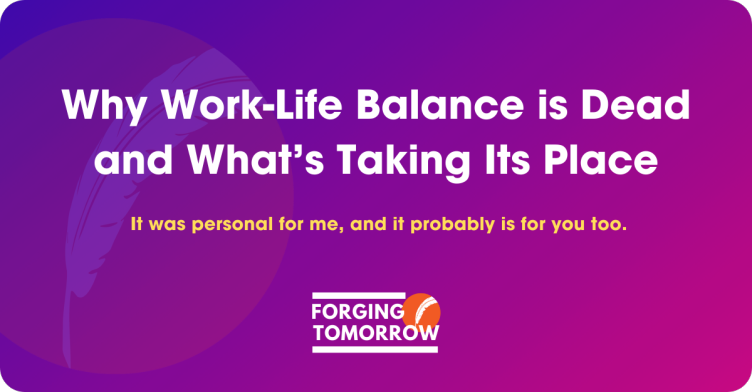It was personal for me, and it probably is for you too
It all started when I was working in my first retail job. I was still in high school, my dad had just passed away, my mom had no job, and my little brother needed support.
So, I got to work.
I worked every available hour, slept a few hours a night, and put in the time to graduate high school with high enough scores to try to get a scholarship. That was the only way I would likely get to college and keep a promise I made to my dad.
Months into this journey, the pace started to wear on me, and my manager pulled me into his office. It was the first time I remember getting a lecture about work-life balance. He asked about what I did in my spare time, what I did for fun, and what I did to relax.
The conversation was confusing to me. I was on a mission to provide for my family. I was energized by knowing I was doing what I set out to do.
I felt judged and contemplated how to appease my boss’ need for me to have answers to those questions. Not only that, but I tried to enjoy new hobbies, but everything I did felt like I was moving away from my goal – getting my family on a better path.
I decided he was mistaken. I decided everyone was wrong except for one person: my dad. He said there was no greater need than to provide for my family. So, that’s what I did.
It took a few years, but I fulfilled all the financial obligations. I was the highest-earning salesperson at my job and got promoted to have only one job. A long-standing career in sales leadership was born.
No regrets.
I’m telling this story because I don’t subscribe to the idea of work-life balance. I want to make a case – from personal experience – for a different way to think about how we live energized and engaged at work and home without putting them on a proverbial scale to balance them.
Others have written about it – but this is my story, position, and life.
I hope it connects with someone personally and validates that you aren’t crazy. You’re just different.
And that’s okay.
Don’t take my word for it.
Let’s start with a definition from the Society for Human Resource Management:
Work/life integration (WLI) is a holistic approach that seeks to blend personal and professional needs. Rather than treating work and life as separate entities or creating a conflict between them, the goal of WLI is to find areas of compromise and synergy. – Arlene S. Hirsch
Or perhaps you’re more of a scholarly article person and get into the research. You can check out this paper as well.
Integration is a solution representing a holistic strategy including effective and efficient coordination of efforts and energies among all stakeholders sharing interest and benefits from workers being able to fulfill their personal, work, family, and community obligations.
Those references go back to 1978, which begs the question, “Why are we even talking about work-life balance?”
Let’s start from the beginning.
Like to teach what you learn? Download the slides to save some time.
The Flaws in the Work-Life Balance Narrative
The Origin of Work-Life Balance
In the late 20th century, when factory whistles were giving way to office keyboards, a phrase caught the collective imagination: “work-life balance.”
It was the golden fleece for the modern worker. Born in an era of industrialization, work-life balance promised a kind of occupational utopia where one could clock out at 5 PM and still catch their kid’s baseball game or make it to a yoga class.
It was a dream tailored for the corporate ladder, a lifestyle fit for TV dinners and “Leave It to Beaver” reruns.
But here’s the hitch—our lives have evolved. Our work has transcended physical offices, our communication is instant, and our responsibilities are ever-shifting. The term’s rigid structure is now ill-equipped to accommodate the fluid nature of contemporary life.
One Size Doesn’t Fit All
Companies historically built the 9-to-5 framework assuming that humans are cogs in a machine, all operating at peak efficiency during the same hours.
But let’s get real; humans aren’t cogs, and time is not one-size-fits-all. Especially with the modern workforce, shaped, in part, by a pandemic.
There are the night owls whose creativity soars when the moon is high, the early birds chirping away at dawn, and let’s not forget the parents coordinating carpools and conference calls.
We’ve also got side hustlers burning the midnight oil and digital nomads working across multiple time zones. How can a 20th-century construct like work-life balance still hold water in this diverse landscape?
Simply put, it can’t.
The old mold of work-life balance is just a square peg failing to fit into the round holes of our diverse lives.
Here’s the paradox: the pursuit of work-life balance can throw you off balance. The psychological toll of segmenting our lives into neatly labeled boxes—‘Work’ here and ‘Life’ there—can be mentally exhausting.
The constant switching between roles, the cognitive load of separating personal chores from professional tasks—it’s a lot to juggle.
And then there’s the guilt. Missing a family dinner because of a deadline or skipping a team meeting for a doctor’s appointment can lead to feelings of inadequacy in both realms.
The result? Stress, burnout, and a persistent sense that you’re falling short in the areas you strive to balance. It’s like trying to stand on a seesaw; any movement in one direction causes a totter in the other.
Introducing Work-Life Integration
A More Dynamic Approach
Step aside, work-life balance; there’s a new kid in town: work-life harmony. Work-life harmony isn’t just another corporate catchphrase; it’s an ideology that aligns more realistically with our lives today.
We’re talking about a model that embraces the fluctuating rhythms of a 24/7 world. It’s a concept that challenges the compartmentalization of our lives and promotes the idea that work and life can—and often do—feed into each other in a positive loop.
It’s not about dividing your pie into rigid slices; it’s about blending the ingredients to make one fantastic pie.
Flexibility Over Rigidity
Suppose work-life balance is the vinyl record of the personal development world. In that case, work-life harmony is the Spotify playlist—tailored to you, accessible anywhere, and updated in real-time. Flexibility is the cornerstone here.
Have you missed your morning workout? No problem; you can reschedule it during your lunch break.
Need to check emails after dinner? Go ahead, as long as you can unwind later.
Your work and life aren’t in conflict; they’re in concert, each flexing to the other’s tempo.
Reducing Stress Through Integration
The beauty of work-life harmony is that it tackles the stress issue head-on. By integrating different aspects of your life, rather than separating them, you eliminate the pressure of living up to the impossible standards of work-life balance.
Take a midday break to watch your kid’s school performance and find you’re more productive in the afternoon. That’s work-life harmony in action.
It allows for ebbs and flows, making room for life’s surprises without compromising productivity.
Implementing Work-Life Integration in Leadership
Embracing the Fluidity of Roles
As a leader, you’re not just steering a ship but part of an intricate ecosystem constantly in motion.
The first step to implementing work-life harmony is acknowledging that you wear multiple hats throughout the day, and that’s okay. Maybe you’re the boss in the morning, the coach in the afternoon, and the parent or spouse in the evening.
It’s not about flipping a switch between roles; it’s about the seamless transition like a DJ smoothly transitioning between tracks, that creates an overall harmonious experience.
Leading by Example
Change starts at the top. If you’re gunning for work-life harmony within your team, you have to walk the
walk. This means respecting your time as well as that of your team. Let them see you take breaks, spend time with family, or indulge in a hobby.
It’s not just about showing vulnerability; it’s about setting a precedent that living a full life is acceptable, not just a work-centric one.
Your team will respect you more, and you’ll likely see a spike in productivity and overall morale.
Empowering Team Autonomy
The ultimate goal is cultivating an environment where your team can operate like a jazz ensemble—individuals empowered to improvise within a framework.
Flexibility in work schedules, freedom to pursue personally meaningful projects, and an ethos that respects individuality—all contribute to work-life harmony.
The result? A team that is not just punching the clock but is engaged, committed, and harmoniously integrated with their work.
Conclusion: The Symphony of Modern Life
The pursuit of work-life balance has been a staple of modern work culture, often held up as the gold standard of personal and professional fulfillment. However, as we’ve dissected today, this antiquated model has limitations, especially in a complex and fluid world.
Enter work-life integration—the more nuanced, flexible cousin of work-life balance. It promises a better alignment with our 24/7 lifestyles and serves as a beacon for leadership in the new age. By adopting a work-life harmony mindset, leaders can improve their lives and drive a more engaged, happy, and effective team.
So, let’s stop trying to balance an inherently unbalanced equation. Instead, let’s strive for harmony and integration, understanding that work and life are two instruments in the same orchestra, each playing its part to create the symphony of modern life.



